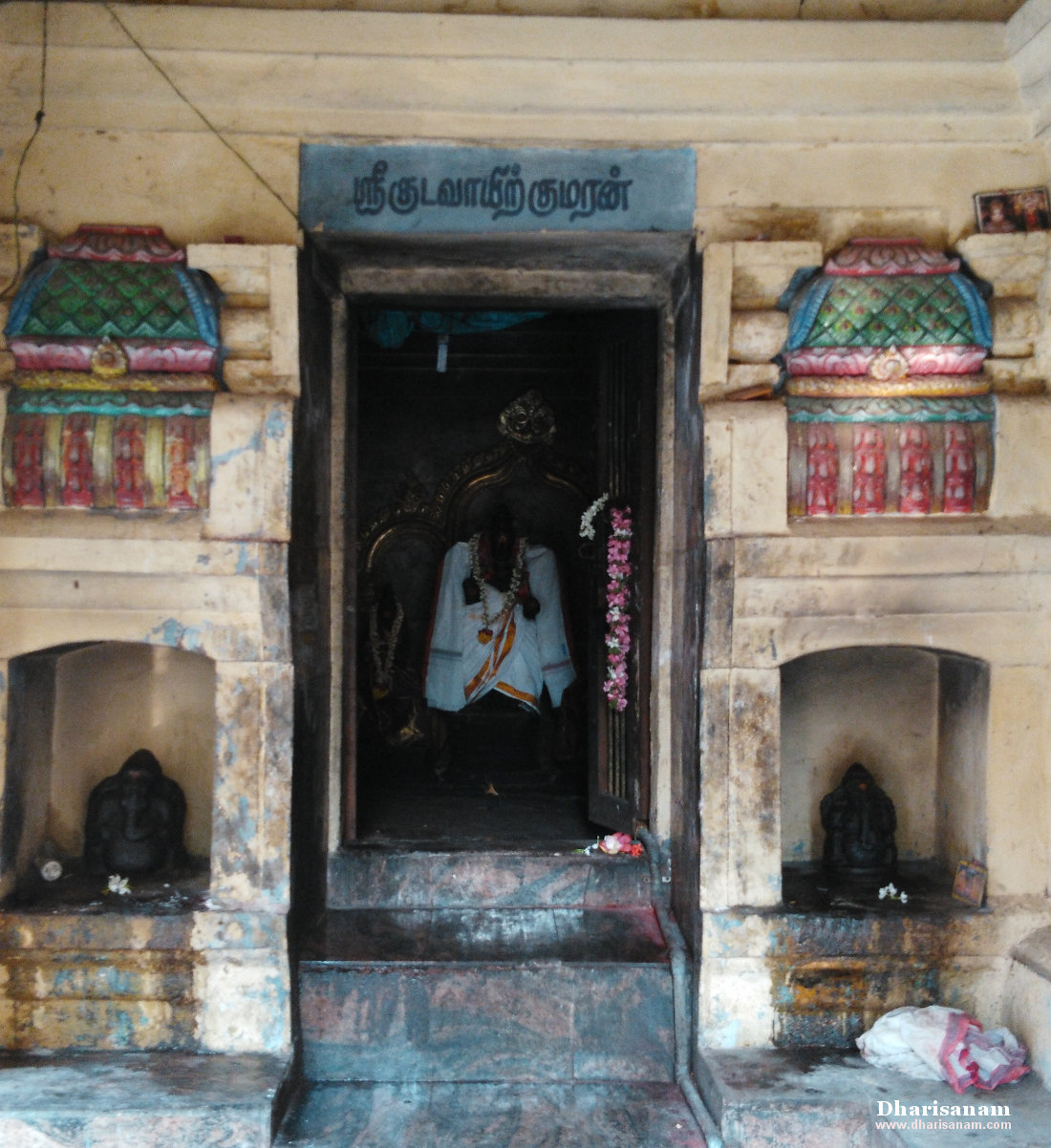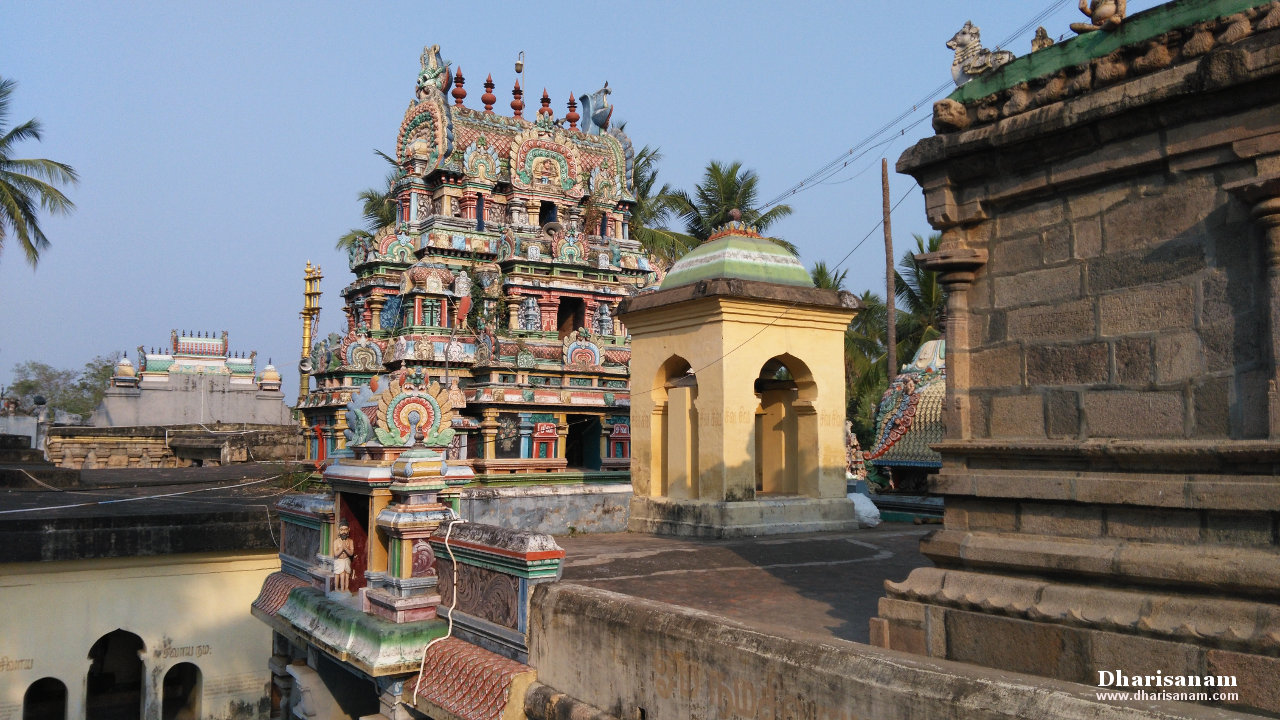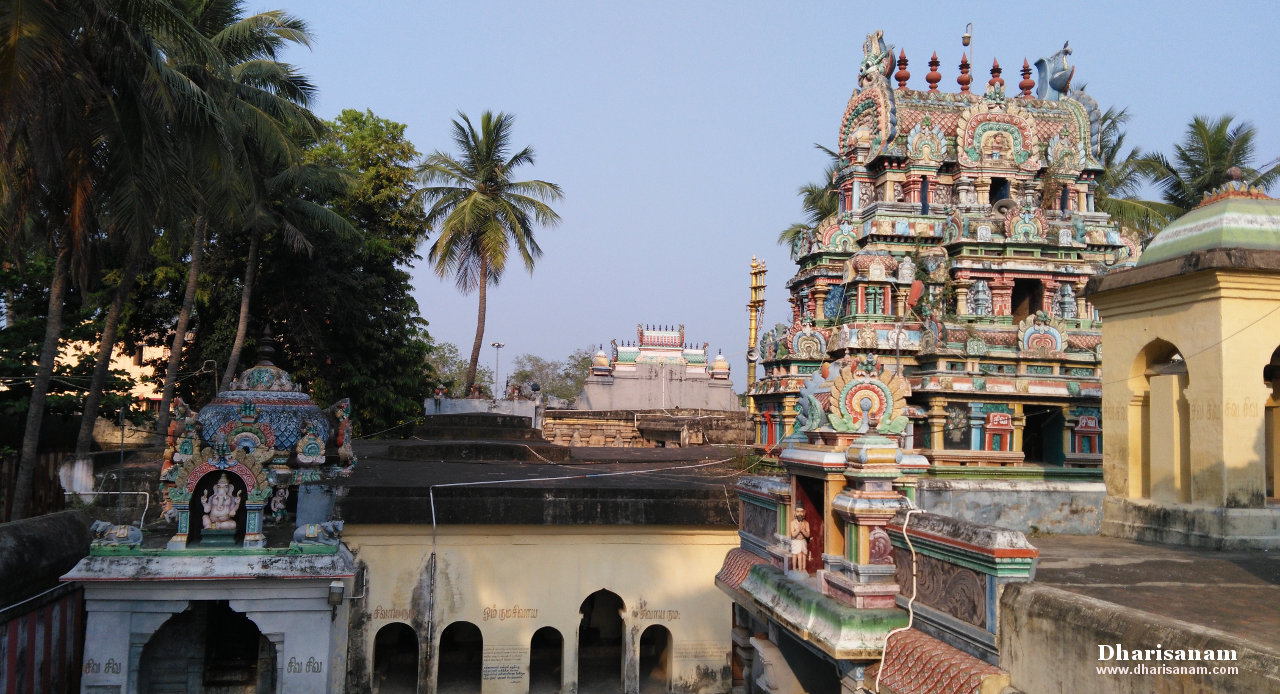Visited on: April 1, 2018.
Location
Kudavayil (Kudavasal) is situated at a distance of about 18 kms south-east of Kumbakonam on the Kumbakonam to Thiruvarur route. From Thiruvarur, it is about 16 kms.
Other Devara Paadal Petra Shiva Sthalam near this place are – Thirucherai, Thalaiyalangaadu, Peruvelur, Karaveeram, Nalur Mayanam, Kaduvaikarai Puthur (Andankoil), Thiru Kollamputhur, Penu Perunthurai, Naraiyur Siththecharam, Arisirkarai Puthur, Sivapuram, Karukkudi and Kalayanallur.
General Information
| Moolavar | Sri Koneswarar, Sri Suryeswarar, Sri Birugu Nathar |
| Ambal | Sri Periyanayaki, Sri Brahannayaki |
| Theertham (Holy water) | Amritha Theertham |
| Sthala Vriksham (Sacred Tree) | Vaazhai (Plantain tree) |
| Pathigam (Hymn) rendered by | Saint Thirugnanasambanthar-2 |
- This is one of the 276 Devara Paadal Petra Shiva Sthalams and 94th Shiva Sthalam on the Southern bank of the river Cauveri in Chozha Nadu (Thenkarai).
- Lord Shiva in this temple is a Swayambumurthi (self-manifested).
- This temple is counted as one of the Maadak Koils built by King Kochengat Cholan.
- This west facing temple has two corridors and its main tower is not tiered. In place of the Gopuram, there is a beautiful sculpture depicting Lord Shiva and Goddess Parvathy.
- The last consecration ceremony (Maha Kumbabishekam) took place in the year 2012 and prior to that on 27.06.1985 and 10.06.1970.
History of the Temple
This ancient temple was built by King Kochengat Chola. This is a Maadak Koil and it has 18 steps to reach Lord Shiva’s shrine. The lower part of this temple is known as “Kudavayir Kottam”. It is believed that Kochengat Chola imprisoned one of his enemies, Seran Kanaikkal Irumporai in this kottam.
This temple finds mention in the Puranaanuru and Aganaanuru texts of the Sangam period (300 BC – 300 CE) literatures. The songs by famous poets Kudavayil Keerthanar and Kudavayil Nallathanar are also part of Aganaanuru.
The historical names of this place are Garudathiri, Kathalivanam and Vanmikaachalam. This temple’s historical name is “Perunthirukkoil”.
There are four stone inscriptions in this temple which date back to the period of Chola King Kulothungan-III.
This temple is under the administrative control of the Hindu Religious and Charitable Endowments Department of Government of Tamil Nadu (HR&CE). 


Legend
According to Hindu mythology, at the end of every “yuga”, there is a huge flood that leads to the destruction of all living beings in the earth. This is called the “Pralayam”. Lord Shiva, through Lord Brahma, arranged for the seeds of all living organisms and four Vedas and Puranas to be put in a pot (“Amutha Kalas” or Kumbham or Kudam in Tamil) filled with nectar (“amirtham”). This was decorated with flowers and cloth and a string was tied to it. This was kept on top of the Mount Kailash. When the Maha Pralayam started, it destroyed all living creatures on the earth. The Amutha Kalas also got displaced and started floating on the seas for years. Eventually when the Pralayam stopped, the Kalas settled in Kumbakonam. Then Lord Shiva took the form of a hunter (Kiratha Murthy) and split open the pot with his arrow. The life on earth started flourishing again.
It is believed that when Lord Shiva opened the pot with his arrow, the pot broke and the decorative items on it fell in various places across the earth. Each of these pieces became Shivalingams.
These places are -
- Kumbesam – this is the place where the Amutha Kalas stayed. This is presently known as Sri Aadhi Kumbeswarar temple (“Aadhi” means “the very beginning”). It is believed that Lord Kiratha Murthy himself made a Shivalingam with the broken pieces of the Kalas by mixing nectar and sand with it. He worshiped this lingam and stayed back in this place. The Shivalingam is in the shape of the neck of a pot (“Kudamukku” in Tamil).
- Somesam – This is the place where the Kalas’s string (“Uri” / “Sikkam” in Tamil) fell. This place is presently known as Sri Someswarar temple.
- Nagesam – This is the place where the Kalas’s “vilvam” (leaf used in poojas) fell. This place is presently known as Sri Nageswarar temple.
- Abhimugesam – This is the place where the Kalas’s coconut fell. This place is presently known as Sri Abhimugeswarar temple.
- Gautamesam – This is the place where the Kalas’s sacred thread fell. This place is presently known as Sri Gautameswarar temple.
- Kudavoil - This is the place where the Kalas’s rim fell. This place is presently known as Sri Koneswarar temple at Kudavasal.
- Kalayanallur (Saakkottai) – This is the place where the mid-portion of the Kalas fell. This place is presently known as Sri Amirthakalasa Nathar temple.
- Bhanathurai, - This is the place where Lord Shiva broke the Kalas with his arrow. This place is presently known as Sri Bhanapureeswarar temple.
- Maalathivanam – This is the place where the Kalas’s flowers fell. This place is presently known as Sri Aathikampatta Viswanathar temple.
- Sri Kalahastheeswarar Koil – This is the place where the Kalas’s “Chandan” fell.
- Sri Ekambareswarar temple - This is the place where the Kalas’s other decorative items fell.
- Kottaiyur Sri Koteeswarar temple - This is the place where some drops of the nectar fell.
The nectar from the Kalas is believed to have reached the Mahaamaham and Potraamarai tanks.
This nectar is also believed to have spread around an area of about 24 kms. In this radius, there are five Shiva temples which are known as “Panchakurosa Sthalams” (“pancha means five and “kurosa” is a unit of measurement used in ancient times). These temples are Thiruvidaimaruthur, Koranattu Karuppur, Thirunageswaram, Swamimalai, and Dharasuram.
There is another version of this legend that involves Garudan (Garudazhvar), the eagle god and also the king of birds. Sage Kasyaba had two wives, Kathru and Vinathai. Garudan was the son of Vinathai. Vinathai was bound to Kathru as a slave. Kathru demanded the nectar from the celestial world to release Vinathai. To save his mother, Garudan flew to the celestial world and got the pot of nectar. While returning, a demon tried to snatch this pot from Garudan. Garudan placed the pot on a nearby anthill and fought with the demon and defeated him. However, when he came back to retrieve the pot, he could not find it as it had gotten covered by the anthill. He tore down the anthill with his sharp beak and was surprised to find a Shivalingam there. Lord Shiva appeared in front of Garudan. Garudan prayed to the lord asking him to save his mother. Lord Shiva rescued Vinathai from the bondage of Kathru. Garudan stayed here to worship the lord and also built this temple. Further, it is believed that this Shivalingam that Garudan discovered was actually the Kalas’s rim that fell here.
The scratch marks from Garudan’s beak can still be seen on the Shivalingam. There is an idol of Garudan in this temple and sculptures of Garudan can also be seen in the compound walls of the temple. It is interesting to note that this is a feature usually seen in Vaishnava temples.

It is believed that Garudan, Suryan, Agni, Jadayu, Sages Suthama, Thalappiyar, Birugu and Thirunapindhu have worshiped the lord here.
It is believed that Sage Thirunapindhu worshiped the lord here. The lord was pleased by his worship and as a blessing, he cured the sage’s leprosy.
Deities in the temple
Other than the shrines of Lord Shiva and Goddess Parvathy, shrines and idols of Vinayakar, Murugan (“Kudavayir Kumaran”) with his consorts, Thanthontrinathar, Kasi Viswanathar, Natarajar, Dakshinamurthy, Chandikeswarar, Sapthamathas, Navagraham, Bairavar (2), Chandran, Suryan, Soodha Munivar, Saneeswarar, few Shivalingams, Vinayakar with few Nagars, Nalvar, Sundaramurthy Nayanar with Paravai Nachiyar, Idumban, Dhandapani, Kalaimagal (Saraswathi) and Gajalakshmi can be seen in the main hall and corridors.
There is also an idol of Garudan who can be seen worshiping Lord Shiva.
There is no Durgai here as Goddess Parvathy herself is depicted as Brahathdurgai.








Salient Features
It is believed that few drops of the “Amirtham” (nectar) fell in this temple’s Theertham (tank). Hence, taking a dip in this tank during the Maha Maham festival at Kumbakonam is considered very auspicious. This tank is in front of the temple and a Vinayakar shrine is also present on the bank of this tank.
This temple is considered to be significant for its three important attributes – Moorthy, Sthalam and Theertham - glory of Lord, sacredness of the land and the auspicious temple tank.
Lord Shiva here is also praised as “Sri Vanmeekanathar” as he was taken out from an anthill (“vanmeekam”) by Garudan.
In this temple, there are few Vinayakar shrines in the names of Sidhdhi Vinayakar, Anumathi Vinayakar, Aathi Gaja Nathar and Maalai (evening) Vazhipaattu Vinayakar.
It is believed that Lord Suryan (Sun) worships Lord Shiva of this temple by directing his rays on the Shivalingam every year for three days in the Tamil month of Panguni (Mar-Apr).
There are many beautiful sculptures (sudhai) on the towers that depicts various legends from Hindu mythology.


It is believed that King Kochengat Chola built about 70 “Madakkoils”. The distinguishing feature of a Madakkoil is that it is not easily approachable by an elephant. He built these temples at an elevation and there are a few steps that need to be climbed before seeing the lord. Also, the sanctum sanctorum’s (Karpagragam) entrance is narrow such that no elephant can enter it.
In his hymn, Saint Thirugnanasambanthar refers to this madakkoil as “Ezhilkola Mada Koil” meaning an “extremely beautiful mada temple”.
Saint Arunagirinadhar has sang songs in praise of Lord Murugan of this temple in his revered Thirupugazh.
Greatness of this temple
Devotees make it a practice to worship Lord Shiva, Suryan and Chandran here. It is believed that by doing so, they will be absolved of the sins that they have accrued by not performing the rituals for their ancestors (“Sradh”).
Devotees also worship Lord Shiva of this temple for prosperity and wisdom.
Important Festivals
Some of the important festivals celebrated in this temple are –
Vaikasi Visakam in the Tamil month of Vaikasi) May-June),
Aani Thirumanjanam in the Tamil month of Aani (June-July),
Aadi Pooram in the Tamil month of Aadi (July-Aug),
Vinayakar Chaturthi in the Tamil month of Aavani (Aug-Sept),
Navarathri in the Tamil month of Purattasi (Sept-Oct),
Skanda Shashti and Annabishekam in the Tamil month of Aippasi (Oct–Nov),
Thiru Karthikai in the Tamil month of Karthikai (Nov-Dec),
Thiruvadhirai in the Tamil month of Markazhi (Dec-Jan),
Maasi Maham and Shivrathri in the Tamil month of Maasi (Feb-Mar) and
Panguni Uthiram in in the Tamil month of Panguni (Mar-Apr).
Pradosham is also observed regularly.
Temple Timings
From 07.00 AM to 12.00 Noon and from 04.00 PM to 08.30 PM.
Temple Address
Sri Koneswara Swami Temple,
Kudavayil (Kudavasal) Post & Taluk,
Thiruvarur District,
Tamil Nadu – 612 601.
The temple priest Sri Chandrasekara Gurukkal can be contacted at 94439 59839.





Pathigam (Hymn) with English transliteration
Saint Thirugnanasambanthar visited this temple and sang this Pathigam.
Devotees visiting this temple should make it a practice to recite this Pathigam.
திகழுந் திருமா லொடுநான் முகனும்
புகழும் பெருமான் அடியார் புகல
மகிழும் பெருமான் குடவா யில்மன்னி
நிகழும் பெருங்கோ யில்நிலா யவனே.
“Thikazhun thirumā loṭunāṉ mukaṉum
pukazhum perumāṉ aṭiyār pukala
makizhum perumāṉ kuṭavā yilmaṉṉi
nikazhum peruṅkō yilnilā yavaṉē”.
ஓடுந் நதியும் மதியோ டுரகம்
சூடுஞ் சடையன் விடைகொல் கொடிமேல்
கூடுங் குழகன் குடவா யில்தனில்
நீடும் பெருங்கோ யில்நிலா யவனே.
“Ōṭun nathiyum mathiyō ṭurakam
chūṭuñ chaṭaiyaṉ viṭaikol koṭimēl
kūṭuṅ kuzhakaṉ kuṭavā yilthaṉil
nīṭum peruṅkō yilnilā yavaṉē”.
கலையான் மறையான் கனலேந் துகையான்
மலையா ளவள்பா கமகிழ்ந் தபிரான்
கொலையார் சிலையான் குடவா யில்தனில்
நிலையார் பெருங்கோ யில்நிலா யவனே.
“Kalaiyāṉ maṟaiyāṉ kaṉalēn thukaiyāṉ
malaiyā ḷavaḷpā kamakizhn thapirāṉ
kolaiyār silaiyāṉ kuṭavā yilthaṉil
nilaiyār peruṅkō yilnilā yavaṉē”.
சுலவுஞ் சடையான் சுடுகா டிடமா
நலமென் முலையாள் நகைசெய் யநடம்
குலவுங் குழகன் குடவா யில்தனில்
நிலவும் பெருங்கோ யில்நிலா யவனே.
“Sulavuñ chaṭaiyāṉ suṭukā ṭiṭamā
nalameṉ mulaiyāḷ nakaisey yanaṭam
kulavuṅ kuzhakaṉ kuṭavā yilthaṉil
nilavum peruṅkō yilnilā yavaṉē”.
என்றன் உளமே வியிருந் தபிரான்
கன்றன் மணிபோல் மிடறன் கயிலைக்
குன்றன் குழகன் குடவா யில்தனில்
நின்ற பெருங்கோ யில்நிலா யவனே.
“Eṉtṟaṉ uḷamē viyirun thapirāṉ
kaṉtṟaṉ maṇipōl miṭaṟaṉ kayilaik
kuṉtṟaṉ kuzhakaṉ kuṭavā yilthaṉil
niṉtṟa peruṅkō yilnilā yavaṉē”.
அலைசேர் புனலன் னனலன் னமலன்
தலைசேர் பலியன் சதுரன் விதிரும்
கொலைசேர் படையன் குடவா யில்தனில்
நிலைசேர் பெருங்கோ யில்நிலா யவனே.
“Alaisēr puṉalaṉ ṉaṉalaṉ ṉamalaṉ
thalaisēr paliyaṉ sathuraṉ vithirum
kolaisēr paṭaiyaṉ kuṭavā yilthaṉil
nilaisēr peruṅkō yilnilā yavaṉē”.
அறையார் கழலன் னழலன் னியலின்
பறையாழ் முழவும் மறைபா டநடம்
குறையா அழகன் குடவா யில்தனில்
நிறையார் பெருங்கோ யில்நிலா யவனே.
“Aṟaiyār kazhalaṉ ṉazhalaṉ ṉiyaliṉ
paṟaiyāzh muzhavum maṟaipā ṭanaṭam
kuṟaiyā azhakaṉ kuṭavā yilthaṉil
niṟaiyār peruṅkō yilnilā yavaṉē”.
வரையார் திரள்தோள் அரக்கன் மடியவ்
வரையா ரவொர்கால் விரல்வைத் தபிரான்
வரையார் மதில்சூழ் குடவா யில்மன்னும்
வரையார் பெருங்கோ யில்மகிழ்ந் தவனே.
“Varaiyār thiraḷthōḷ arakkaṉ maṭiyav
varaiyā ravorkāl viralvaith thapirāṉ
varaiyār mathilchūzh kuṭavā yilmaṉṉum
varaiyār peruṅkō yilmakizhn thavaṉē”.
பொன்னொப் பவனும் புயலொப் பவனும்
தன்னொப் பறியாத் தழலாய் நிமிர்ந்தான்
கொன்னற் படையான் குடவா யில்தனில்
மன்னும் பெருங்கோ யில்மகிழ்ந் தவனே.
“Poṉṉop pavaṉum puyalop pavaṉum
thaṉṉop paṟiyāth thazhalāy nimirnthāṉ
koṉṉaṟ paṭaiyāṉ kuṭavā yilthaṉil
maṉṉum peruṅkō yilmakizhn thavaṉē”.
வெயிலின் நிலையார் விரிபோர் வையினார்
பயிலும் முரையே பகர்பா விகள்பால்
குயிலன் குழகன் குடவா யில்தனில்
உயரும் பெருங்கோ யிலுயர்ந் தவனே.
“Veyiliṉ nilaiyār viripōr vaiyiṉār
payilum muraiyē pakarpā vikaḷpāl
kuyilaṉ kuzhakaṉ kuṭavā yilthaṉil
uyarum peruṅkō yiluyarn thavaṉē”.
கடுவாய் மலிநீர் குடவா யில்தனில்
நெடுமா பெருங்கோ யில்நிலா யவனைத்
தடமார் புகலித் தமிழார் விரகன்
வடமார் தமிழ்வல் லவர்நல் லவரே.
“Kaṭuvāy malinīr kuṭavā yilthaṉil
neṭumā peruṅkō yilnilā yavaṉaith
thaṭamār pukalith thamizhār virakaṉ
vaṭamār thamizhval lavarnal lavarē”.







